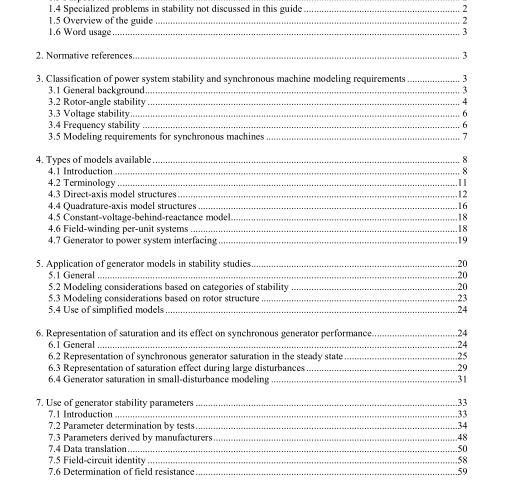IEEE 1110-2019 pdf download.IEEE Guide for Synchronous Generator Modeling Practices and Parameter Verification with Applications in Power System Stability Analyses
This guide contains instructions for modeling synchronous machines in direct- and quadrature-axis equivalent circuits, along with the basic transient and subtransient reactance/time-constants model in view of stability studies. It discusses assumptions made in using various models and presents the fundamental equations and concepts involved in generator/system interfacing. The manner in which generator saturation is treated in network studies, both in the initialization process as well as during large or small disturbance stability analysis procedures is addressed. Approaches for improving the accuracy of field and excitation system quantities are identified and conversion factors are given for transferring field parameters from one base to another for correct generator/excitation system interface modeling. Parameter determination and translation from equivalent-circuits to operational impedances or vice-versa is covered. Data analysis methods for obtaining these parameters using measurements from field tests or finite-element computations are explained and illustrated with a wide range of generator and test data. However, this guide refers to applicable standards (such as IEEE Std 115) or contract specification for scheduling such tests. Also, this guide does not attempt to recommend specific procedures for machine representation in non-standard or atypical cases such as generator tripping and overspeed operation or models for harmonics or unbalanced operation.
1.3 Purpose
The modeling of synchronous machines for stability studies and analyses is subject to continuing review and possible improvements. The guide addresses both parameter identification for static and dynamic stability analyses while accounting for generator saturation. Emphasis is placed on discussing various aspects of synchronous generator/power system interactions in steady and dynamic operation modes.
1.4 Specialized
problems in stability not discussed in this guide This guide does not attempt to recommend specific procedures for machine representation in non-standard or atypical cases such as generator tripping and overspeed operation or models for harmonics or unbalanced operation. Similarly, modeling suggestions for subsynchronous resonance (SSR) studies are documented in Dandeno and Iravani [B10] and IEEE [B35]. Recent investigations have shown that models developed from small-signal analyses, based on standstill-frequency-response data, are also adequate for SSR investigations. This applies to situations where third-order models have been found to be necessary to cover the frequency spectrum from 15 Hz to 50 Hz (IEEE [B35]).
1.5 Overview of the guide
Clause 3 discusses the various categories of stability studies that are commonly performed during power system studies and the corresponding synchronous generator modeling requirements. Clause 4 then reviews some of the basic principles of synchronous generator modeling and discusses the range of models which can be used in the study of synchronous generator dynamic behavior as is summarized in Table 1 of Clause 4. This clause emphasizes the point that a model is uniquely determined only when both its structure (e.g., the number of assumed conducting paths in the rotor) and its parameters (as obtained from test data or analytical techniques) are specified. Clause 5 next presents guidelines as to how the various models discussed in Clause 4 can be applied to the various types of stability studies that are discussed in Clause 3.
Clause 6 then discusses the effects of saturation on the performance of synchronous machines and various techniques which have been developed for incorporating these effects in synchronous generator models. Included in Annex D is the development of direct- and quadrature-axis saturation functions. Because saturation is an inherently nonlinear phenomenon while the commonly-used generator models are linear, the techniques used for incorporating saturation effects into generator models are somewhat ad hoc. This is an area in which further investigation is clearly required.
Finally, Clause 7 discusses the techniques that have been developed for obtaining parameters for synchronous generator models. Such parameters are found either by test, as described in IEEE Std 115™-1995, or from calculations by manufacturers. 2 The issue of the translation of parameters from the inductances and resistances of d- and q-axis models to transient and subtransient reactances and time constants or to transfer functions form is also discussed.IEEE 1110 pdf download.IEEE 1110-2019 pdf download
IEEE 1110-2019 pdf download

Leave a Reply